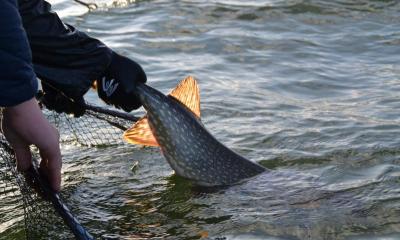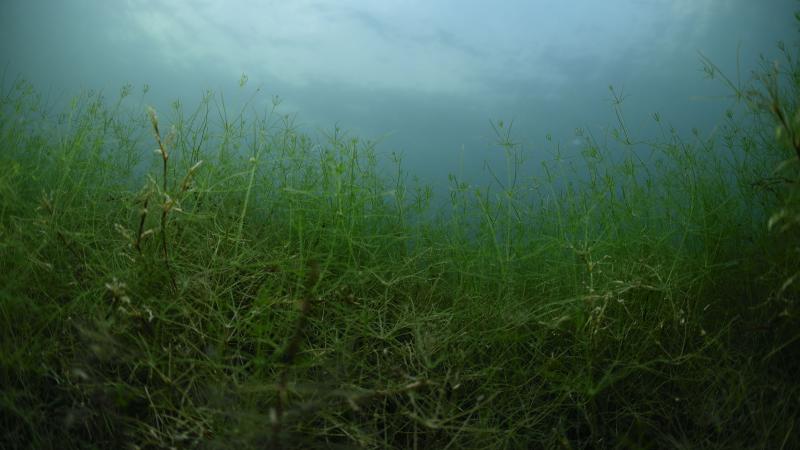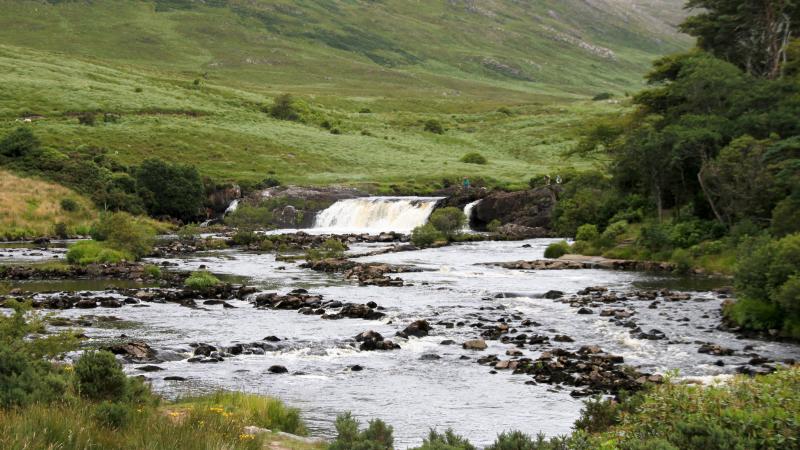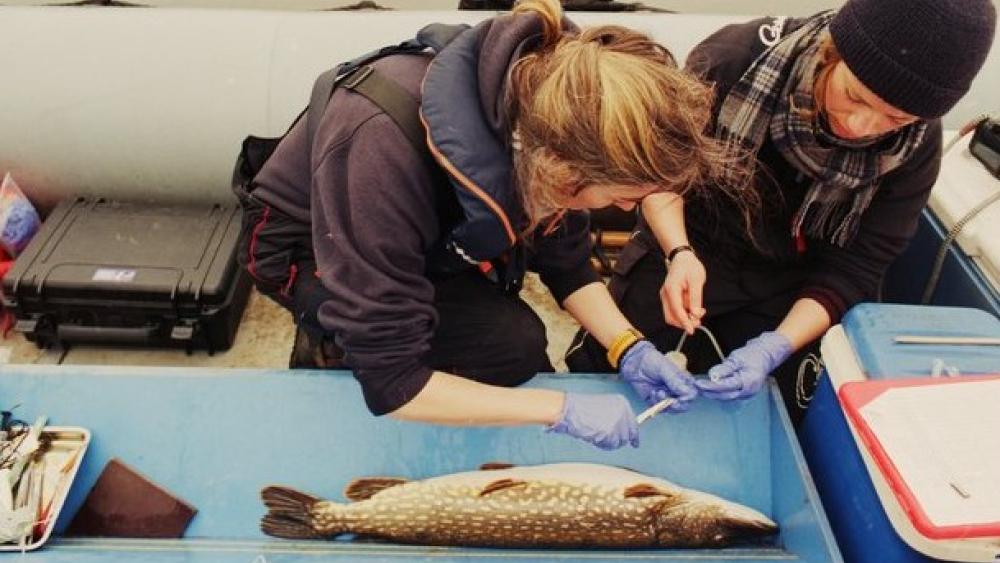
Bodden pike caught, tagged for research purposes and released. | Photo: Falk Weiß
As the research team from the IGB in cooperation with the State Institute of Agriculture, Institute of Fisheries in Rostock and a number of other cooperation partners have been able to prove, the amount of pike in the Bodden has been declining since 2010. There are also indications that the Bodden pike grow significantly slower today as adults than in the past. According to model calculations, the pike stock may have lost half of its productivity. This applies both to the Bodden pike stock as a whole and to the occurrence of large metre pike, which are particularly attractive to anglers and fishing tourism.
"Among the user groups, the decline of the Bodden pike has been criticised for several years. We have now been able to scientifically prove this negative development in the project. The search for the concrete causes is much more complicated. Apparently, the ecological conditions on the Bodden have deteriorated and at the same time fishing and angling are too intensive," explains IGB project leader Prof. Dr. Robert Arlinghaus. "Based on the currently available data and analyses, we assume that the stock is affected by a whole range of environmental changes. At the same time, the removal of pike by commercial and recreational angling fisheries is high, but not the sole reason for the pike decline. Nor can we say on the basis of the data that it is one particular fishing sector alone that is affecting the pike, it is the sum of all vices," adds IGB researcher Dr Elias Ehrlich, who coordinated the participation process of all stakeholders in the project.
Changing environmental conditions take their toll on pike
The pike stock around Rügen suffers not only from fishing but also from high cormorant populations and an overall reduced food availability and quality. As the Bodden is connected to the Baltic Sea, supra-regional factors are at work here: Fat-rich herring, which used to migrate in large numbers to the Bodden in spring, are declining. The invasive round gobies, which are less productive for the larger pike, have increased considerably. This reduces the growth of pike over 70 cm. In addition, reproduction is further restricted by agricultural run-off of nutrients and the large-scale loss of floodplains and blocked access to freshwater tributaries, which lowers resistance to new stressors. Some of the Bodden pike are migratory animals that, like salmon, depend on spawning in freshwater; these subpopulations are now severely threatened. In addition, there are complex effects of climate change that are still not understood in detail. This can affect maturation and egg quality, the timing of the emergence of food organisms and the frequency and occurence of egg and larval predators, such as sticklebacks.
"Because the biological relationships and interactions are so complex, it is not easy to reverse the downward trend through new management strategies," explains Robert Arlinghaus. And he continues: "Conversely, this does not mean that 'business as usual' is advisable. For example, fishing pressure should be adapted to the reduced stock sizes. Professional and recreational fisheries also have a demonstrable influence: Pike from heavily fished stocks outside protected areas not only become less numerous and smaller, but also become increasingly difficult to catch. This effect is felt above all by anglers. For commercial fisheries, on the other hand, the altogether less numerous pike remain relatively easy to catch due to their high swimming activity, especially shortly before the spawning season. This is a problem when fishing intensively with gillnets in the spatially limited spawning bays before the spawning season, as local thinning events can occur that are difficult to compensate for via repopulation from other areas. Overall, our data show that the Bodden pike show high site fidelity and limited spatial movements outside the spawning season".
Management recommendations for stock recovery
The research team has derived clear recommendations for the future from the studies: Habitat enhancement is essential. The restoration of streams and rivers flowing into the Bodden and the creation of floodplains in salt marshes and shoreline areas of the Bodden would contribute to better spawning and growth of the young pike. Nutrient inputs, especially from agriculture, should also be reduced through better catchment management, so that the underwater vegetation increases. A reduction of cormorant populations would also have a positive effect on the pike population according to model analyses, but is controversial from a nature conservation perspective.
Furthermore, numerous fisheries harvest regulations are recommended, e.g. raising the minimum-size limit from currently 50 to 60 cm and introducing a harvest window of 60 to 90 cm. The introduction of a narrow window of permitted mesh sizes for gillnets, in order to equally protect the juvenile and large pike that are important for reproduction, also seems sensible. In addition, migration corridors towards spawning bays and tributaries should be kept free of gillnets, and protected areas free of any form of fishing that are binding for all users should be expanded. Currently, only one percent of the Bodden area is completely excluded from fishing.
For anglers, the daily bag limit could be reduced from the current three to one pike per person per day. Alternatively, it would be conceivable to issue harvest tags per angler, which would regulate the total annual catch, but still allow for several takes per day. Such annual quotas for pike for individual users are missing so far, but would make sense. Should professional fishers restrict themselves in favour of pike stocks and recreational fishing, compensation regulations for yield losses would be a constructive solution. All in all, all previously applicable and new rules should be prepared more clearly for the stakeholders and their compliance in practice should be better monitored.
In addition to these scientific recommendations, also recommendations accepted by all stakeholders were developed in the project, which are often, but not always, congruent with the scientific assessments. The management propositions developed by the stakeholders has already been presented to the Ministry for Climate Protection, Agriculture, Rural Areas and Environment of Mecklenburg-Western Pomerania and recommended for implementation. The comprehensive book now available also explains and substantiates the scientific recommendations in detail.
Conflicts need moderation and a factual basis
Of course, the success of the measures cannot be guaranteed due to the complexity of the situation, the researchers emphasise. In many areas of the central and southern Baltic Sea, pike stocks are declining even though commercial and recreational fisheries have been drastically regulated in some cases. This speaks for the effect of overriding ecological factors that are apparently affecting many fish stocks in and around the Baltic Sea: Cod, herring and other commercially and touristically important species are also in decline. Spared pike could also be eaten by other natural predators such as the increasing grey seal population.
Therefore, the researchers recommend the introduction of continuous bodden fish monitoring and the maintenance of dialogue with practitioners. Conflicts between individual user groups will always exist, and they could increase - especially if measures such as restoration are not implemented immediately, rapid successes fail to materialise, or further restricted fishing opportunities for marine species increase the fishing pressure of professional fishers on freshwater fish in the Bodden. Nature conservation and fisheries do not always see eye to eye either. This is about spatial conflicts, e.g. access to protected areas, or cormorant and grey seal protection, but regularly also about different values and norms, e.g. on the question of what is socially more important - the protection of natural predators, of bird populations in general, or support for fishing. "Resolving these issues requires open discussion with all stakeholders, a political decision and binding implementation by the responsible authorities," Robert Arlinghaus emphasises.
"Because there is no fish stock monitoring in the Bodden, many debates are emotional and based on personal impressions and experiences. Better and objective data like that from the project help to objectify the discussion and find the best possible compromises. It is important that the user groups remain in dialogue despite all the dissent on specific issues. For there are more common interests than many realise - for example, nature conservation and fisheries both have a high interest in the restoration of the Bodden shorelines. We have started a comprehensive participation process in the project, in which representatives of the various interest groups have worked together very successfully at a round table. This process should now be continued," explains Elias Ehrlich.
The pike are a tangible economic factor
The Bodden pike is a relevant economic factor: the fish stocks of the Bodden, including the pike, are used by about 50,000 anglers. About 75 per cent of the anglers on the Bodden come from other federal states than of Mecklenburg-Western Pomerania and are therefore tourists who bring money to the island. "The economic importance of pike fishing on the Bodden is extrapolated to be 32 times higher than that of professional pike fishing - and the trend is downwards, as the stocks are no longer as attractive for angling tourism," explains Robert Arlinghaus. "However, the importance of a fishing sector cannot be read off from the economic figures alone. For example, professional fishing has a cultural value, it is also part of the coastal image and has a long tradition. It is important not to play the fisheries sectors off against each other, but to find compromises that put both groups of actors in a better position than is the case today, and to find management solutions that are perceived as fair and forward-looking," adds project manager Robert Arlinghaus.
Should the pike population continue to decline and no longer be economically viable for coastal fishers and angling tourism providers in the way it used to be, either alternative fish species such as perch, pikeperch, eel or sea trout would have to be fished more intensively, which could also lead to consequential problems - or completely new income models beyond fishing and angling tourism would have to be found. Aquaculture, work in practical nature conservation management as a "Bodden warden" or work as a service provider for Bodden monitoring would be suitable here. Comparable models as "marine foresters" are currently being tested on the outer coast for coastal fishers.
The comprehensive monograph can be downloaded free of charge (in German).
Printed copies are available for a fee directly via Robert Arlinghaus.
The joint recommendations of the stakeholders are also available for download free of charge (in German).
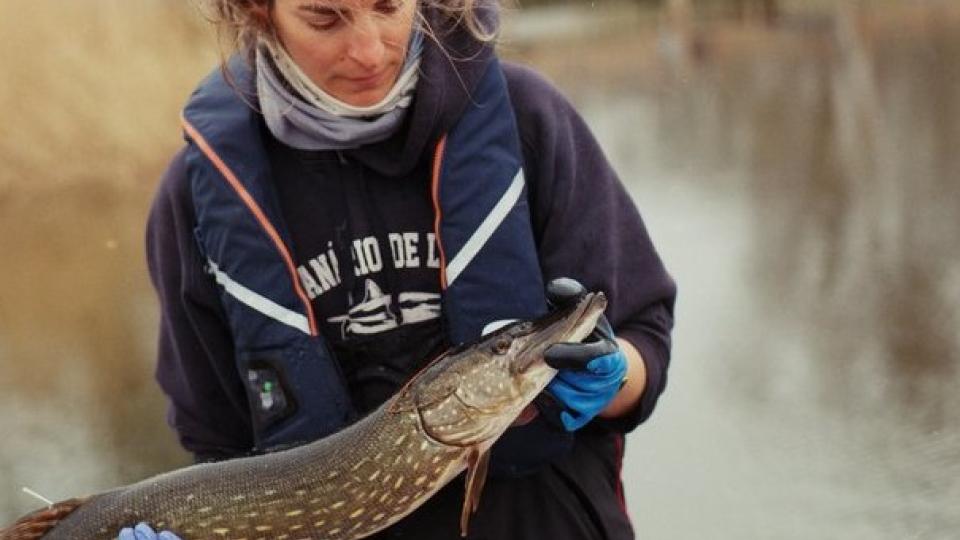
IGB researcher with large pike. | Photo: Falk Weiß
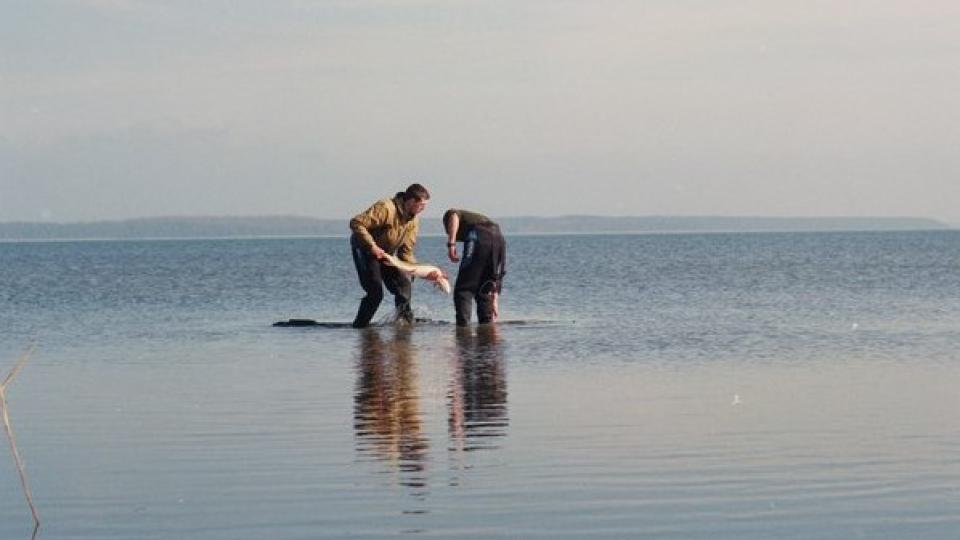
The tagged pike is released. | Photo: Falk Weiß
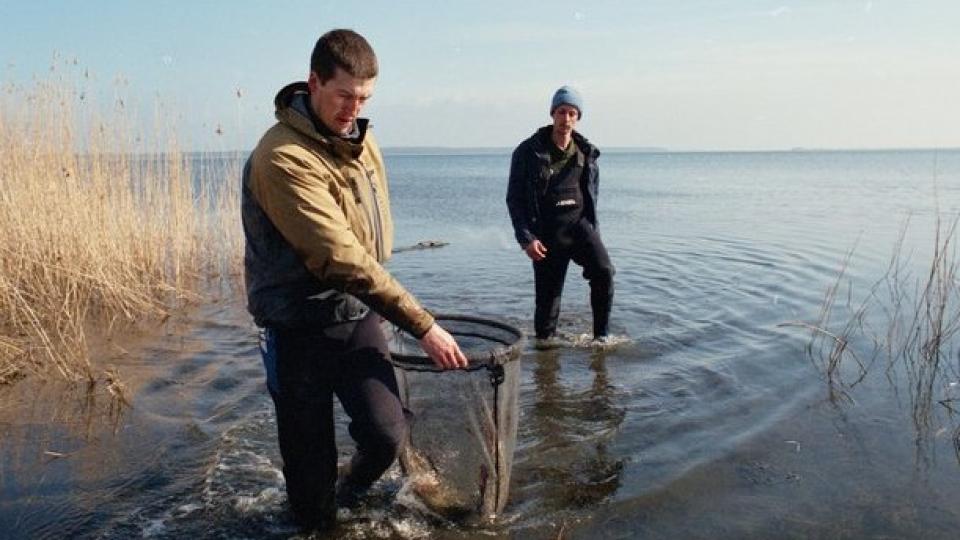
Field research in the Bodden landscape around Rügen. | Photo: Falk Weiß



